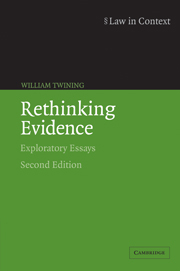Book contents
- Frontmatter
- Contents
- Preface
- Acknowledgements
- List of abbreviations
- Table of cases
- 1 Introduction: the story of a project
- 2 Taking facts seriously
- 3 The Rationalist Tradition of evidence scholarship
- 4 Some scepticism about some scepticisms
- 5 Identification and misidentification in legal processes: redefining the problem
- 6 What is the law of evidence?
- 7 Rethinking Evidence
- 8 Legal reasoning and argumentation
- 9 Stories and argument
- 10 Lawyers' stories
- 11 Narrative and generalizations in argumentation about questions of fact
- 12 Reconstructing the truth about Edith Thompson the Shakespearean and the jurist
- 13 The Ratio Decidendi of the Parable of the Prodigal Son
- 14 Taking facts seriously – again
- 15 Evidence as a multi-disciplinary subject
- Bibliography
- Index
2 - Taking facts seriously
Published online by Cambridge University Press: 15 December 2009
- Frontmatter
- Contents
- Preface
- Acknowledgements
- List of abbreviations
- Table of cases
- 1 Introduction: the story of a project
- 2 Taking facts seriously
- 3 The Rationalist Tradition of evidence scholarship
- 4 Some scepticism about some scepticisms
- 5 Identification and misidentification in legal processes: redefining the problem
- 6 What is the law of evidence?
- 7 Rethinking Evidence
- 8 Legal reasoning and argumentation
- 9 Stories and argument
- 10 Lawyers' stories
- 11 Narrative and generalizations in argumentation about questions of fact
- 12 Reconstructing the truth about Edith Thompson the Shakespearean and the jurist
- 13 The Ratio Decidendi of the Parable of the Prodigal Son
- 14 Taking facts seriously – again
- 15 Evidence as a multi-disciplinary subject
- Bibliography
- Index
Summary
Once upon a time, on the eastern seaboard of Xanadu, a brand new law school was established. An innovative, forward-looking, dynamic young dean was appointed, and he quickly recruited a team of innovative, forward-looking dynamic young colleagues in his own image. At the first faculty meeting – there were as yet no students to complicate matters – the only item on the agenda was, naturally, curriculum. The dean opened the proceedings: ‘Persons,’ he said, ‘there is only one question facing us today: What can we do that is new, creative, innovative, path-breaking …?’ His colleagues nodded assent; being young and forward-looking they had not yet learned that even in legal education there is nothing new under the sun. Suggestions followed quickly: law and the social sciences, a clinical programme, psycho-legal studies, eco-law, computer-based instruction, law and development, and many of the fads, fashions, follies, and frolics of the 1970s and 1960s, and even some from the 1950s (for how far back does the history of legal education stretch?) were all quickly rejected as old hat. They were, in Brainerd Currie's phrase, ‘trite symbols of frustration’. For our subject is governed by a paradox: in general education there is no reported example of an experiment that has ended in failure; in academic law no movement or programme has ever achieved success.
- Type
- Chapter
- Information
- Rethinking EvidenceExploratory Essays, pp. 14 - 34Publisher: Cambridge University PressPrint publication year: 2006
- 4
- Cited by

